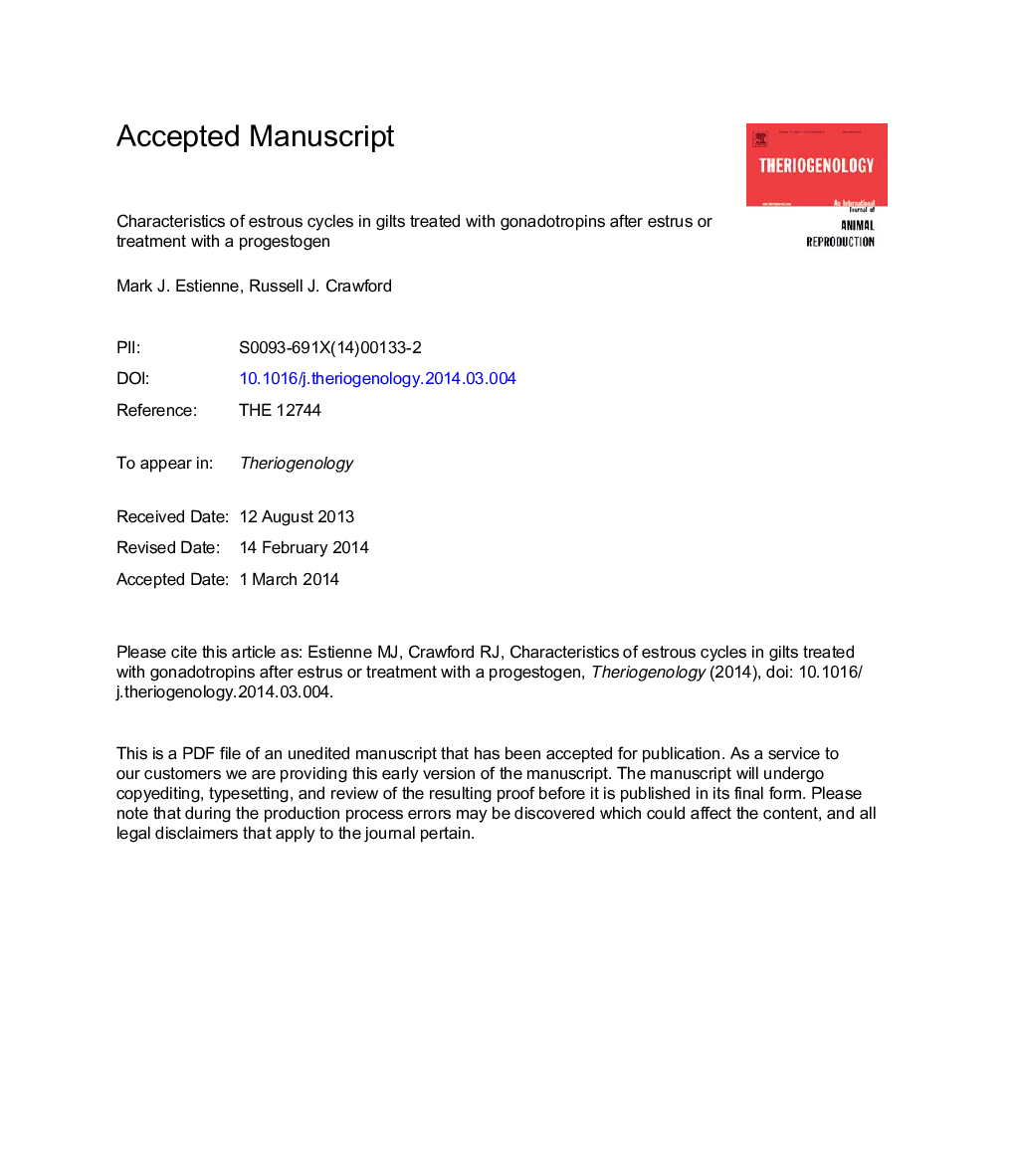| کد مقاله | کد نشریه | سال انتشار | مقاله انگلیسی | نسخه تمام متن |
|---|---|---|---|---|
| 10891966 | 1082082 | 2015 | 23 صفحه PDF | دانلود رایگان |
عنوان انگلیسی مقاله ISI
Characteristics of estrous cycles in gilts treated with gonadotropins after estrus or treatment with a progestogen
ترجمه فارسی عنوان
ویژگیهای چرخه های استروئید در گلیت های درمان شده با گنادوتروپین پس از استروس یا درمان با پروژسترون
دانلود مقاله + سفارش ترجمه
دانلود مقاله ISI انگلیسی
رایگان برای ایرانیان
کلمات کلیدی
موضوعات مرتبط
علوم زیستی و بیوفناوری
علوم کشاورزی و بیولوژیک
علوم دامی و جانورشناسی
چکیده انگلیسی
A combination of eCG (400 IU) and hCG (200 IU) (P.G. 600; Merck Animal Health, Summit, NJ, USA) stimulates puberty in gilts, but variation in the estrual response exists among farms. We hypothesized that some of the variability is a consequence of gilts that have commenced cycling being inadvertently treated. The objective of experiment 1 was to determine the effect of intramuscular (im) P.G. 600 on estrous cycles in sexually mature gilts. Gilts in treatment 1 (n = 16) received P.G. 600 at the onset of daily boar exposure. Gilts in treatments 2 to 5 (n = 16 per treatment) were allowed to express a natural first estrus and were then treated with P.G. 600 during the first estrous cycle as follows: treatment 2 at Day 6, treatment 3 at Day 12, and treatment 4 at Day 18 of the estrous cycle. Treatment 5 gilts received no P.G. 600. The proportion of gilts displaying a normal estrous cycle (18-24 days) was greater (P < 0.05) for treatments 4 (100%) and 5 (100%) compared with treatments 1 (73.3%) and 3 (60%), with treatment 2 having a value (87.5%) that was not different from the other groups. For treatment 3, 33% of gilts displayed an increased interestrus interval that averaged 32.5 days. Concentrations of progesterone remained elevated 20 days after the onset of first estrus in treatment 3 gilts, which supports the concept that P.G. 600 administered at Day 12 of the estrous cycle induced follicular growth, ovulation, and formation of CL that functioned for approximately 15 days, increasing the length of the estrous cycle. It is common for swine producers to have groups of replacement gilts that include both cycling and prepubertal animals, or individuals, the cycling status of which is unknown. The objective of experiment 2 was to evaluate a system using a combination of a progestogen (Matrix; Merck Animal Health) and P.G. 600 to synchronize estrus in replacement gilts. Crossbred gilts, assumed to be a mix of cycling and prepubertal females, were allocated to one of four treatments (n = 12 per treatment): treatment 1, Matrix (15 mg/day) fed for 14 days and im P.G. 600 24 hours after the last feeding of Matrix; treatment 2, Matrix for 7 days and P.G. 600; treatment 3, P.G. 600 only; and treatment 4, im water only. The percentage of gilts in estrus within 7 days after im treatment was the greatest (P < 0.02) and days to estrus the least (P < 0.05) for gilts receiving Matrix for 14 days and P.G. 600 (treatment 1, 91.7% and 5.4 ± 1.9 days; treatment 2, 50% and 9.2 ± 2.0 days; treatment 3, 33% and 13.8 ± 2.1 days; and treatment 4, 50% and 9.1 ± 1.9 days). The results of these experiments suggest that P.G. 600 administered to gilts that have already obtained puberty may cause abnormal estrous cycles and demonstrate to swine producers the need to correctly classify replacement gilts as prepubertal or cycling before administering the product. The use of Matrix and P.G. 600 in combination has potential as an effective strategy for synchronizing estrus in a mix of prepubertal and mature, cycling gilts.
ناشر
Database: Elsevier - ScienceDirect (ساینس دایرکت)
Journal: Theriogenology - Volume 83, Issue 4, 1 March 2015, Pages 459-465
Journal: Theriogenology - Volume 83, Issue 4, 1 March 2015, Pages 459-465
نویسندگان
Mark J. Estienne, Russell J. Crawford,
